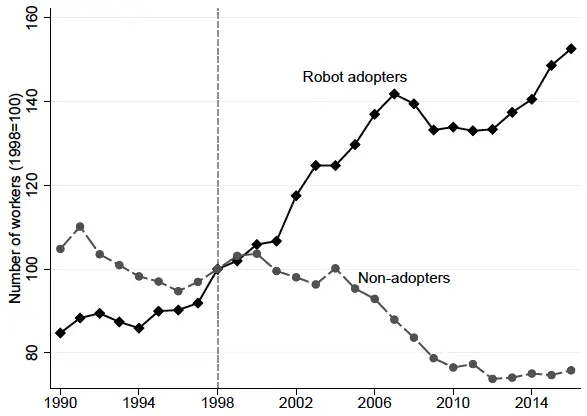
Robot Adopters vs. Non-Adopters
A comprehensive study based upon data from Spain shows a stark contrast between firms that adopt robot technology and those that do not. Spain has one of the highest robot density levels per worker in Europe. The data come from the Encuesta Sobre Estrategias Empresariales (ESEE), an annual survey of around 1,900 Spanish manufacturing firms with very detailed information about firms’ manufacturing processes, including the use of robots and other advanced technologies, costs, prices, employment, and so forth.
The graph of Robot Adopters vs. Non-Adopters, which is constructed from the ESEE dataset, provides a clear indication that the adoption of robots greatly influences the labor market. It shows that firms that adopted robots between 1990 and 1998 (‘Robot Adopters’) increased the number of jobs by more than 50% between 1998 and 2016, while firms that did not adopt robots (‘Non-Adopters’) reduced the number of jobs by more than 20% over the same period.
This study provides striking conclusions regarding the implications of production automation and robot technology. The data strongly suggests that Robot Adopters expand their scale of operations and create jobs, while Non-Adopters experience negative output and employment effects in the face of tougher competition. Aggregate productivity gains are partly driven by substantial intra-industry reallocation of market share and resources. In other words, high-productivity Robot Adopters take market share and jobs from low-productivity Non-Adopters. Contrary to some misconceptions around robots, embracing automation will grow jobs and the economy.




